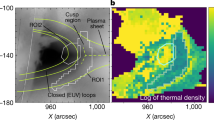Abstract
IT seems very improbable that the bright line spectrum of the inner corona can be attributed to thermal excitation of the coronal matter. We may seek its cause in the process of photoelectric ionisation and apply then, as a first and rough estimate of its brightness, the same analysis as Dr. Zanstra has done in the case of diffuse nebulæ (Astrophys. Jour., 65, No. 1). Thus we assume in this approximation that the emission spectrum of the corona is due to a mechanism of recombination of free electrons with atoms, ionised by the high quantum radiation, emerging from the sun, acting as a black body radiator; and that the corona consists only of monoatomic hydrogen. We have to suppose, further, that the high quantum radiation is completely absorbed by the coronal material, and that all the freed electrons recombine with the ionised hydrogen atoms.
This is a preview of subscription content, access via your institution
Access options
Subscribe to this journal
Receive 51 print issues and online access
$199.00 per year
only $3.90 per issue
Buy this article
- Purchase on Springer Link
- Instant access to full article PDF
Prices may be subject to local taxes which are calculated during checkout
Similar content being viewed by others
Author information
Authors and Affiliations
Rights and permissions
About this article
Cite this article
ZESSEWITSCH, W., NIKONOW, W. Emission Lines in the Spectrum of the Solar Corona. Nature 123, 909–910 (1929). https://doi.org/10.1038/123909b0
Issue Date:
DOI: https://doi.org/10.1038/123909b0
Comments
By submitting a comment you agree to abide by our Terms and Community Guidelines. If you find something abusive or that does not comply with our terms or guidelines please flag it as inappropriate.



